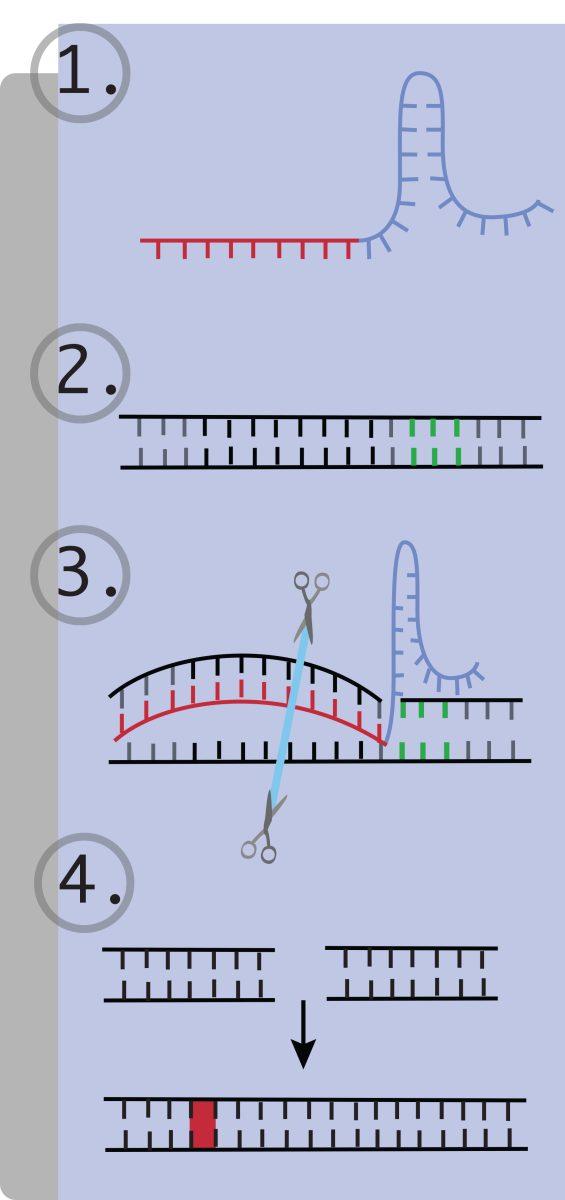Trimming, changing and replacing DNA could revolutionize modern medicine and prevent common medical conditions, like HIV and cancer.
A new genetic modifying tool called CRISPR-Cas9 is being researched at Texas A&M’s College of Veterinary Medicine and Biomedical Sciences. This ground-breaking research targets a specific area of genome and allows researchers to cut out and insert new DNA. This would mean monumental breakthroughs in medicine, allowing humans to repair genes responsible for diseases.
Peter Nghiem, assistant professor in the College of Veterinary Medicine and Biomedical Science, said his lab is currently researching in canine trials the use of CRISPR-Cas9 to fight duchenne muscular dystrophy, or DMD — a disorder caused by a genetic mutation that deteriorates muscle as humans age.
“We have engineered a CRISPR-Cas9 platform that has target this specific mutation in these DMD cells,” Nghiem said. “So the goal is excise out the mutation and replace it with the correct sequence. We hope with our research and the research of other labs around the world we can develop a editing therapy for boys with duchenne muscular dystrophy.”
According to the Centers for Disease Control and Prevention, one of the leading causes of death in the United States is cancer. Nghiem said he expects to see CRISPR-Cas9 used as a common method in the future to treat cancer.
“For clinical trials in people, if you go to the government’s website and you can look up the different clinical trials that are available, you’re most likely going to see several therapies using CRISPR-Cas9 directed at cancer related conditions and also other conditions with a genetic component,” Nghiem said.
Charles Long, A&M professor in the Department of Veterinary Physiology and Pharmacology, is currently researching the use of CRISPR-Cas9 in enhancing production traits in livestock. Long said that the potential uses of this new tool to edit the genome raises some ethical questions.
“For instance in China and Europe right now, they are allowing early experimentation on human embryos,” Long said. “To use this technology to essentially prevent the passing on of genetic mutations that cause disease to the offspring. So the most difficult quest for our society is, ‘Is that okay?,’ ‘Can we use a technology to cure a disease in an individual that doesn’t exist yet?’”
Nghiem said that this unprecedented technology comes with new risks and a call for greater precaution while conducting research.
“With any DNA targeting therapy you always worry about off target effects that may occur,” Nghiem said. “So if you target a specific part of the genome there always going to be another part of the genome that is very similar to the one that you’re going after. So you also have to check to see if there are any other affects with your CRISPR-Cas9.”
The potential of CRISPR doesn’t end with DMD, it can be applied to virtually any field in medicine. Molika Sinha, a graduate student performing stem-cell research, said the developing potential of this new technique could be more widespread
“Stem-cell research and this technology of gene editing is developing at a very fast rate,” Sinha said. “For example, most retinal diseases like blindness are being corrected by using stem cells or gene editing techniques.”
In regard to the potential negative outcomes of using CRISPR-Cas9 or similar methods, Long said he is confident in the potential solutions these techniques provide.
“The wonderful thing about gene editing is that we can do just about anything you can dream up,” Long said. “But also the wonderful thing about gene editing is that we can probably engineer around any problem that occurs.”
Speaking on the future of gene editing and application of the CRISPR-Cas9 platform, Long says that he is optimistic about the what this new technique means for the future of medicine and biological sciences.
“CRISPR is simply opening a door to new things we’ve never imagined before,” Long said. “I would imagine within the next ten or so years there will be another major change in how we approach genome engineering — it will make it more precise, it will make it safer, and it will make it to where it is more broadly applicable.”
Long said that the more broad application of CRISPR, is that it will allow researchers in all fields of biology a method to easily study the genetics of different species. CRISPR is revolutionary because it gives researchers a new tool to study basic things that are not understand about how organisms live and how organisms interact with their environments.
“CRISPR is more than just being able to go in and change a gene,” Long said. “The reason it’s such a big thing is that it allows every aspect of investigation in biology an opportunity to do things they never been able to do before — and that really changes everything.”
Modifying Medicine
October 11, 2016
Donate to The Battalion
Your donation will support the student journalists of Texas A&M University - College Station. Your contribution will allow us to purchase equipment and cover our annual website hosting costs.























